DNA-Matching Androids to Help ID 600 MH17 Bodies and Remains

Ukrainian emergency workers carry a victim's body in a bag, at the crash site of Malaysia Airlines Flight 17 near the village of Hrabove, eastern Ukraine Evgeniy Maloletka/AP
Unknown whether there will be enough genetic evidence to name all 298 passengers.
Dutch officials expect precise accuracy from DNA-matching software that will be used to identify many of the 298 Malaysia Airlines flight MH17 victims. But it is unknown whether there will be enough genetic evidence from the remains and relatives of the missing to ID everyone.
As of Friday, 171 people who died after the July 17 crash had not been recovered.
Shortly after the disaster, the Netherlands Forensic Institute, a nonprofit, government-owned agency, was tasked with the DNA-matching portion of an ID effort led by international experts from the Dutch National Forensic Investigations Team.
"The NFI received DNA samples that were taken from over 600 bodies and body parts," institute spokeswoman Suzan Demirhan told Nextgov on Tuesday. "We were asked to make a DNA profile of each sample."
In order to link remains to a last name, automated technology called "Bonaparte," as in Napoleon, will be used. In 1811, French emperor Bonaparte established a Dutch registry of births, deaths and marriages that required a last name from everyone.
Bonaparte will compare the DNA profiles from body parts against each other, and against DNA samples provided by relatives of the missing, officials said.
The institute's automaton has a good track record. Bonaparte helped name the 103 passengers killed by a 2001 Afriqiyah Airways crash over Tripoli -- in less than three weeks.
When several children in a family are missing, it is possible to identify them by extracting cell material from personal objects, according to a July institute report on identifying victims of large-scale disasters. As many as 80 children were killed when MH17 was downed by an allegedly Russian-made missile.
"The software recognizes patterns of similarity in the DNA profiles," the July report states. "When the DNA profile of a body (or body part) fits the DNA profiles in a family tree, Bonaparte subsequently calculates the scientific evidentiary value of that resemblance."
Genetic matches are not always the basis for identification. Often, fingerprints or dental records provide enough forensic evidence to determine someone's name.
Institute officials said they do not have data on how many of the 127 identifications were derived from DNA matches.
Genetic samples can be taken from the muscle or bone tissue of a victim, as well as a molar or tooth.
But DNA matching is not always perfect, according to experts. A landmark 2009 National Research Council study on the strength of U.S. forensic science found that while "DNA analysis is considered the most reliable forensic tool available today, laboratories nonetheless can make errors," such as mislabeling samples, losing samples or misinterpreting the data.



